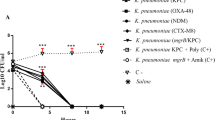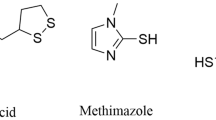Abstract
Usage of cephalosporin and quinolone antibiotics has aggravated the development of extended-spectrum beta-lactamase (ESBL)–producing quinolone-resistant (QR) pathogenic Enterobacteriaceae. The present study aims to determine antimicrobial activity of cinnamaldehyde alone or in combination with cefotaxime/ciprofloxacin to reverse the drug resistance and evaluations of efficacy, and possible molecular mechanism of action of the combination was also evaluated using in vitro assays. Broth microdilution assay was used to determine minimum inhibitory concentrations (MICs) of cinnamaldehyde and antibiotics against ESBL-QR Enterobacteriaceae. Synergistic effect and dynamic interaction with antibiotics were further examined by checkerboard assay, isobologram analysis, and time-kill assay, respectively. Cellular morphology of bacteria was viewed with scanning electron microscopy (SEM). Effects of cinnamaldehyde and its combination on the expression of gene encoding—porins (ompC, ompF, ompK35, and ompK36), efflux pump genes (acrB–E. coli, acrB–K. pneumoniae), and antibiotic-resistant genes (blaTEM, blaSHV, blaCTXM, and QnrB) were evaluated using real-time quantitative PCR (RT-qPCR). Majority of the E. coli (32.1%) and K. pneumoniae (24.2%) isolates demonstrated MIC of cinnamaldehyde at 7.34 μg/mL and 0.91 g/mL, respectively. Synergism between cinnamaldehyde and cefotaxime was noted among 75% E. coli and 60.6% K. pneumoniae. Similarly, synergism with ciprofloxacin was observed among 39.6% and 42.4% of the bacteria, respectively. Thus, cinnamaldehyde reduced MIC of cefotaxime and ciprofloxacin 2–1024-fold with bactericidal and/synergistic effect after 24 h. Cinnamaldehyde and its combination altered gene expression by ~ 1.6 to ~ 400-fold. Distorted bacterial cell structures were visible after treatment with cinnamaldehyde and/or with cefotaxime/ciprofloxacin. The results indicated the potential efficacy and mode of action of cinnamaldehyde alone and in combination with antibiotics against pathogenic ESBL-QR bacteria.





Similar content being viewed by others
References
Chandra H, Bishnoi P, Yadav A, Patni B, Mishra AP, Nautiyal AR (2017) Antimicrobial resistance and he alternative resources with special emphasis on plant-based antimicrobials-a review. Plants (Basel) 10(2):6
Frank T, Mbecko JR, Misatou P, Monchy D (2011) Emergence of quinolone resistance among extended-spectrum beta-lactamase-producing Enterobacteriaceae in the Central African Republic: genetic characterization. BMC Res Notes 25:309
Laxminarayan R, Chaudhury RR (2016) Antibiotic resistance in India: drivers and opportunities for action. PLoS Med 13:e1001974
Alekshun MN, Stuart B (2007) Molecular mechanisms of antibacterial multidrug resistance. Cell 128:1037–1050
van Hoek Angela HAM, Mevius D, Guerra B, Mullany P, Roberts Paul A, Aarts Henk JM (2011) Acquired antibiotic resistance genes: an overview. Front Microbiol 2:1–27
Atanasov AG, Waltenberger B, Pferschy-Wenzig EM, Linder T, Wawrosch C, Uhrin P et al (2015) Discovery and resupply of pharmacologically active plant-derived natural products: a review. Biotechnol Adv 33:1582–1614
Jia P, Xue YJ, Duan XJ, Shao SH (2011) Effect of cinnamaldehyde on biofilm formation and sarA expression by methicillin-resistant Staphylococcus aureus. Lett Appl Microbiol 53:409–416
López P, Sanchez C, Batlle R, Nerín C (2007) Vapor-phase activities of cinnamon, thyme, and oregano essential oils and key constituents against foodborne microorganisms. J Agric Food Chem 55:4348–4356
Liu Q, Niu H, Zhang W, Mu H, Sun C, Duan J (2015) Synergy among thymol, eugenol, berberine, cinnamaldehyde and streptomycin against planktonic and biofilm-associated food-borne pathogens. Lett Appl Microbiol 60:421–430
Palaniappan K, Holley RA (2010) Use of natural antimicrobials to increase antibiotic susceptibility of drug resistant bacteria. Int J Food Microbiol 140:64–68
Hossan MS, Jindal H, Maisha S, Samudi Raju C, Devi Sekaran S, Nissapatorn V, Kaharudin F, Su Yi L, Khoo TJ, Rahmatullah M, Wiart C (2018) Antibacterial effects of 18 medicinal plants used by the Khyang tribe in Bangladesh. Pharm Biol 56:201–208
Clinical and Laboratory Standards Institute (2008) Performance standards for antimicrobial susceptibility testing; eighteenth informational supplement, Document M100-S18. CLSI, Wayne, PA
Garcia L (2010) Synergism testing: broth microdilution checkerboard and broth macrodilution methods. In: Garcia L (ed) Clinical microbiology procedures handbook, 3rd edn. ASM Press, Washington, pp 140–162
Chou TC (2006) Theoretical basis, experimental design, and computerized simulation of synergism and antagonism in drug combination studies. Pharmacolo Rev 58:31
Zhou XY, Ye XG, He LT, Zhang SR, Wang RL, Zhou J, He ZS (2016) In vitro characterization and inhibition of the interaction between ciprofloxacin and berberine against multidrug-resistant Klebsiella pneumoniae. J Antibiot (Tokyo) 69:741–746
Salmi C, Loncle C, Vidal N, Letourneux Y, Fantini J, Maresca M, Taïeb N, Pagès JM, Brunel JM (2008) Squalamine: an appropriate strategy against the emergence of multidrug resistant gram-negative bacteria? PLoS One 23:e2765
Cui Y, Kim SH, Kim H, Yeom J, Ko K et al (2012) AFM probing the mechanism of synergistic effects of the green tea polyphenol (2)-epigallocatechin-3-gallate (EGCG) with cefotaxime against extended-spectrum beta-lactamase (ESBL)-producing Escherichia coli. PLoS One 7:e48880
Justice SS, Hunstad DA, Cegelski L, Hultgren SJ (2008) Morphological plasticity as a bacterial survival strategy. Nature 6:162–168
Bos J, Zhang Q, Vyawahare S, Rogers E, Rosenberg SM, Austin RH (2015) Emergence of antibiotic resistance from multinucleated bacterial filaments. Proc Natl Acad Sci U S A 112:178–183
Wang Y, Zhang Y, Shi YQ, Pan XH, Lu YH, Cao P (2018) Antibacterial effects of cinnamon (Cinnamomum zeylanicum) bark essential oil on Porphyromonas gingivalis. Microb Pathog 116:26–32
Helander IM, Alakomi HL, Kyösti KL, Mattila-Sandholm T, Pol I, Smid EJ (1998) Characterization of the action of selected essential oil components on gram-negative bacteria. J Agric Food Chem 46:3590–3595
Shen S, Zhang T, Yuan Y, Lin S, Xu J, Ye H (2015) Effects of cinnamaldehyde on Escherichia coli and Staphylococcus aureus membrane. Food Control 47:196–202
García-Salinas S, Elizondo-Castillo H, Arruebo M, Mendoza G, Irusta S (2018) Evaluation of the antimicrobial activity and cytotoxicity of different components of natural origin present in essential oils. Molecules 23:1399
Raja SB, Murali MR, Devaraj SN (2008) Differential expression of OmpC and OmpF in multidrug-resistant Shigella dysenteriae and Shigella flexneri by aqueous extract of Aeglemarmelos, altering its susceptibility toward beta-lactam antibiotics. Diagn Microbiol Infect Dis 61:321–328
Raja SB, Murali MR, Malathi GK, Anbarasu K, Devaraj SN (2009) Effect of aqueous extract of Aegle marmelos fruit on adherence and β-lactam resistance of Enteropathogenic Escherichia coli by down regulating outer membrane protein C. Am J Infect Dis 5:161–169
Karumathil DP, Nair MS, Gaffney J, Kollanoor-Johny A, Venkitanarayanan K (2018) Trans-cinnamaldehyde and eugenol increase Acinetobacter baumannii sensitivity to beta-lactam antibiotics. Front Microbiol 9:1011
Zhou X, Jia F, Liu X, Wang Y (2012) Total alkaloids of Sophorea alopecuroides-induced down-regulation of AcrAB-TolC efflux pump reverses susceptibility to ciprofloxacin in clinical multidrug resistant Escherichia coli isolates. Phytother Res 261637–43
Cai W, Fu Y, Zhang W, Chen X, Zhao J, Song W et al (2016) Synergistic effects of baicalein with cefotaxime against Klebsiella pneumoniae through inhibiting CTX-M-1 gene expression. BMC Microbiol 16:181
National Toxicology Program (2004) NTP toxicology and carcinogenesis studies of trans-cinnamaldehyde (CAS no. 14371-10-9) in F344/N rats and B6C3F1 mice (feed studies). Natl Toxicol Program Tech Rep Ser 514:1–281
Acknowledgments
The authors are extremely grateful to the Director, Calcutta School of Tropical Medicine, Kolkata, India, for providing necessary facilities for this study.
Funding
This study is funded by the Indian Council of Medical Research (Grant No. -58/67/BMS-2012).
Author information
Authors and Affiliations
Corresponding author
Ethics declarations
Conflict of interest
The authors declare that they have no conflict of interest.
Ethical statement and informed consent
The study was approved by the ethical research committee (reference number: CREC-STM/53 dated 23/09/2011). Informed consent was obtained from the patients for participating in the study.
Additional information
Publisher’s note
Springer Nature remains neutral with regard to jurisdictional claims in published maps and institutional affiliations.
Rights and permissions
About this article
Cite this article
Dhara, L., Tripathi, A. Cinnamaldehyde: a compound with antimicrobial and synergistic activity against ESBL-producing quinolone-resistant pathogenic Enterobacteriaceae. Eur J Clin Microbiol Infect Dis 39, 65–73 (2020). https://doi.org/10.1007/s10096-019-03692-y
Received:
Accepted:
Published:
Issue Date:
DOI: https://doi.org/10.1007/s10096-019-03692-y




